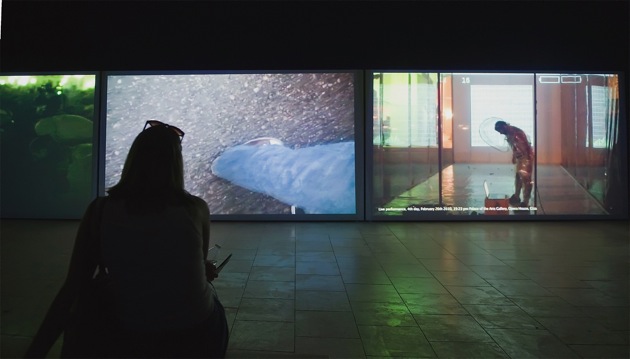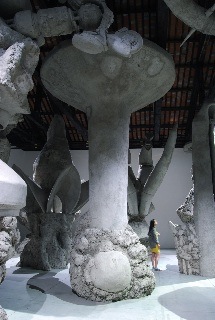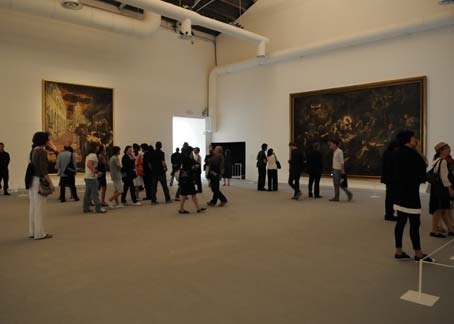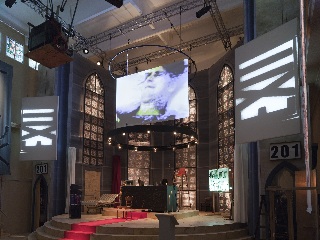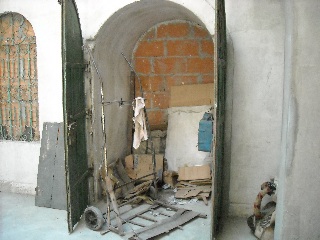Has the Venice Biennale outlived its usefulness? By most indications, the question is specious. Witness the preview leading to the public unveiling of the fifty-fourth edition of the gigantic international exhibition of contemporary art in early June. Though long ago the Biennale got so big as to overspill its already commodious accommodations in the city’s Giardini and the warrens of the one-time shipbuilding hangars of the Arsenale, it continues to metastasize each year, with a greater number of national pavilions in this edition than ever before (ninety-one countries had signed on before the last-minute defections of Lebanon and Bahrain). Several countries––Saudi Arabia, Bangladesh, Haiti, Andorra––participated for the first time, while others, including India, Zimbabwe, South Africa, Congo, and Cuba, returned with national pavilions after lengthy absences.
The crowd of new participants was mirrored by the crush of visitors. In addition to the usual gaggle of curators and museum directors, vulpine collectors, slithery yacht-borne oligarchs, and pop celebrities a decade or more removed from their last hit record, the festivities drew in a handful of politicians as well. Israeli president Shimon Peres paid a visit to artist Sigalit Landau’s Israeli pavilion, and Argentine president Cristine Fernández de Kirchner inaugurated the opening of her country’s pavilion, a rousing installation by Adrián Villar Rojas of tightly bunched, bulky brutalist forms made of drab clay that nearly scraped the soaring ceiling above.
But if Venice is still the premier international contemporary-art bonanza, it may have become a victim of its own success. Part of the problem is logistics. The sheer number of pavilions, some of them dispersed throughout the city in hard-to-find locations—even out on the Isola di San Servolo in the Lagoon—make it impossible for all but the most intrepidly determined to see the entire show. (The mushrooming number of official ancillary shows and independent collection exhibitions, many of them set in spectacular locales dotting the Grand Canal, doesn’t make the completist’s task any easier.) But with so many pavilions competing—in many cases, considerably well—for attention and recognition, the pressure on the International Exhibition at the heart of the Biennale is a greater challenge for its selected curator than ever before. The International Exhibition is the decisive element that can provide at least a measure of cohesion and thoughtful, higher-level argument amid the cacophony of individual statements made by the national pavilions.
Against this background, the International exhibition, “ILLUMInations,” did itself few favors. Organized this year by the Swiss critic Bice Curiger, editor of the bellwether magazine Parkett and curator since 1993 at the Zurich Kunsthaus, the show of eighty-eight artists in the International Pavilion and the Arsenale isn’t so much good or bad as remarkably unmemorable. Curiger has long enjoyed a reputation for being a consummate insider in contemporary art, but her most striking curatorial decision here is a nod not to the present but to the Venetian painting patrimony: the installation of three Tintoretto canvases borrowed from the Accademia (The Stealing of the Body of St. Mark and The Creation of the Animals) and the San Giorgio Maggiore Basilica (The Last Supper). While Curiger’s choice of the voluptuously light-filled works by the painter known as Il Furiosi to establish the “ILLUMInations” theme is an unorthodox, even inspiring one, the execution fizzles. Poorly lighted in the cavernous white cube of the International Pavilion, the paintings are drained of much of their startling swagger.
Still, in an exhibition dedicated to contemporary art, Tintoretto’s work is by definition an outlier, and in including it, Curiger seems to want to infuse the show with the rebellious energy of Rimbaud signaled in the exhibition’s title. Yet her show is well stocked with the expected pieces by artists of boggling international repute—newish wallpaper work by Cindy Sherman, a set of Sigmar Polke’s protean paintings on lenticular, light-bending surfaces, a room of Fischli & Weiss’s deadpan sculptures overseen by the full moon embossed on the wall––which fail to cohere as a group in any but the most fleeting way. Save for the old-master introduction, a walk through the International exhibition has all the payoff of a good afternoon stroll in Chelsea. Little seems specific to the Biennale itself.
The odd works that have the potential to add some dissenting texture to the mostly flat feel of the exhibition are often diminished by curt or self-defeating display. Christopher Wool’s recent suite of Rorschach-like, minimally colored silk-screened paintings are claustrophobically bunched together in an uncomfortable space. A selection of David Goldblatt’s South African photographs are overwhelmed by the drone music from the nearby exhibition of the young London artist Haroon Mirza, an installation that features the slack detritus of flashing reflector strips and a vitrine containing a hunk of gold that literally bounces up and down from the throbbing beat.
Advertisement
The Arsenale, where the majority of “ILLUMInations” is installed, is likewise curiously anodyne—not really bad, just lacking in curatorial verve. The centerpiece of the exhibition is three oversized wax sculptures, including a replica of Giambologna’s Rape of the Sabine Women, by the Swiss artist Urs Fischer, featured in last year’s New Museum midcareer survey and in any number of newspaper accounts of winning bids at Christies and Sotheby’s. Fischer’s sculptures-cum-candles slowly melt into a heap over the course of the exhibition, a gesture of iconoclasm that is as vacant as the puddles of wax are pretty.
It seems somehow fitting that the grand finale in the Arsenale, and one of the largest spaces devoted to any work of art, is given over to Christian Marclay’s installation The Clock, the Swiss artist’s seamless 24/7 montage that sutures snippets of found film clips in which a timepiece flashes the hour and minute corresponding to the very moment the viewer is seeing the installation. A genuine crowd-pleaser, it’s also familiar, having been shown at The White Cube in London and The Paula Cooper Gallery in New York and written about [extensively] (https://www.nybooks.com/articles/archives/2011/apr/28/killing-orson-welles-midnight/) — the art fair equivalent of comfort food that goes down well no matter where it’s consumed.
Give one piece of credit to “ILLUMINations”: It does call attention to certain themes that are more explicitly figured in the ring of nearby national pavilions, where they’re delivered with an immediacy that seems flagging in the main exhibit. It’s jarring to leave a comfortable seat in front of The Clock and arrive in the Egyptian pavilion to see the time signature images of the Tahrir Square protests taken from Ahmed Basiony’s digital-phone camera––footage the thirty-year-old artist shot in the moments before his death by sniper fire. Interspersed on screens with documentation of a grueling piece of endurance-based performance art by the late artist—he ran in place for a thirty-day period, the heat-sensitive sensors on his shoes and body generating a pulsing, brightly lit display on a monitor—the installation poignantly reminds the visitor to Venice that the Biennale can aspire to much more than the blue-chip propriety that reigns in the international exhibition. It’s no less disconcerting to go from Fischer’s dripping vanitas to the German pavilion, where a stage-set chapel by Christoph Schliengesief provides the most provocative display in the Giardini.
A controversial filmmaker and theater impresario who was selected to represent Germany in the Biennale a year before his death in August at age forty-nine, Schliengensief wed his admiration for Fassbinder, adoration for the do-it-yourself ethos of Super-8 trash cinema, and sincere devotion to the self-mythologizing rituals of ’60s era Fluxus and Joseph Beuys in a career as a prankster whom few in the art world (or in Germany, for that matter, where he was exceedingly well-known) ever knew whether to take entirely seriously. In filling the chapel with his films of reimagined moments from the canon of performance art (e.g., Nam June Paik’s TV Cello, Valie Export’s Touch Cinema) enacted by a motley, mix-raced group of elderly amateurs and members of his troupe alongside relics from his losing battle with cancer (oversize chest X-rays, a video of his final hours), the German pavilion skirts the edge of ghoulishness. But its fixation on the kind of send-off Schliengensief might himself have staged seems perfectly aligned with his own overwrought theater of self-promotion.
How an artist actually represents a country is the whole croce e delizia of the Biennale, and as in past years a number of pavilions have chosen to underscore the burdensome nationalistic heritage of the exhibition. In the case of the Danish pavilion, the solution is simply to punt: rather than feature a selected representative, the organizers chose instead to install an international set of mostly non-Danish artists wrestling with issues around freedom of speech. Far more interesting and creative responses come elsewhere. The Polish pavilion hosts an Israeli artist, Yael Bartana, who documents the (fictional) activities of a political movement agitating for the mass repatriation of Jews to Poland; the British pavilion is painstakingly transformed by the artist Mike Nelson into an absolutely credible, down-to-the-dirt facsimile of a cramped and dusty Turkish caravanserai. (For its part, in the Turkish pavilion artist Ayse Erkmen has built a contraption that amusingly pumps cleanly filtered Venetian water back through a pretzel-logic series of colorful pipes into the green canal.)
Advertisement
Where many pavilions, like those of Serbia, Brazil, and Russia, have given their spaces over to mini-retrospectives of artists unfamiliar outside of their native countries, the Czech representative, Dominik Lang, has installed the work of his late father, a sculptor whose Modernist forms were little appreciated in Communist Czechoslovakia. The result is a lovely time capsule of Lang’s genealogical and historical predecessor. Lang’s contribution is an example of the serendipitous experience that the most rewarding of the Biennale’s national pavilions provide: a simple, subtle, smart, and sensually engaging gesture that opens up a range of impressions––in this case about the course of Czech history and the fate of art-making, realized in an intensely personal project.
No pavilion seems more eager to illustrate the ideological and political baggage of national representation than the American one, by the collaborative team of Jennifer Allora and Guillermo Calzadilla. In the duo’s thumpingly literal-minded piece called “Gloria,” tokens of American mobility, soft power, and finance are pressed into service: an upside-down tank is retrofitted with an exercise treadmill on its top, a fully functioning ATM merges with a pipe organ that emits unique, digitally composed tunes whenever money is withdrawn, a replica of the statue from the dome of the US Capitol lies on its side in an open tanning bed. Separate wings of the American pavilion house ersatz business-class airline seats fabricated out of wood (why that material was chosen is anybody’s guess). At regular intervals, gymnasts recruited from the Olympic team perform real freestyle routines over the unreal seats, which is the closest the installation comes to giving much life to the themes of freedom and constraint that “Gloria” thunders on about.
Every so often, no matter where you are in the Giardini, you hear the bullying rumble of the tank—a British model that Allora and Calzadilla bought and had shipped to Venice, along with the ATM and the organ pipe—revving up for another performance by a runner who mounts the exercise machine on top. It’s as overbearing as the drone beat in “ILLUMInations,” and no more friendly to its fellow pavilions. “Gloria” gambles heavily on its lack of subtlety. In a Biennale that draws most of its strength from the national pavilions, American exceptionalism continues to look—and sound—awfully out of place.
The 54th Venice Biennale will be up until November 27, 2011.


